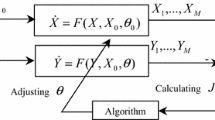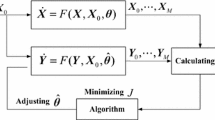Abstract
An accurate mathematical model has a vital role in controlling and synchronization of chaotic systems. But generally in real-world problems, parameters are mixed with mismatches and distortions. This paper proposes two simple but effective estimation methods to detect the unknown parameters of chaotic models. These methods focus on improving the performance of a recently proposed evolutionary algorithm called backtracking search optimization algorithm (BSA). In this research firstly, a new operator to generate initial trial population is proposed. Then a group search ability is provided for the BSA by proposing a shuffled BSA (SBSA). Grouping population into several sets can provide a better exploration of search space, and an independent local search of each group increases exploitation ability of the BSA. Also new proposed operator to generate initial trial population, by providing a deep search, increases considerably the quality of solutions. The superiority of the proposed algorithms is investigated on parameter identification of 10 typical chaotic systems. Practical experiences and nonparametric analysis of obtained results show that both of the proposed ideas to improve performance of original BSA are very effective and robust so that the BSA by aforementioned ideas produces similar and promising results over repeated runs. A considerably better performance of proposed algorithms based on average of objective functions demonstrates that the proposed ideas can evolve robustness and consistence of BSA. A comparison of the proposed algorithms in this study with respect to other algorithms reported in the literature confirms a considerably better performance of proposed algorithms.












Similar content being viewed by others
References
Ahandani MA, Shirjoposh NP, Banimahd R (2010) Three modified versions of differential evolution algorithm for continuous optimization. Soft Comput 15:803–830
Brest J, Greiner S, Boskovic B, Mernik M, Zumer V (2006) Self-adapting control parameters in differential evolution: a comparative study on numerical benchmark problems. IEEE Trans Evol Comput 10:646–657
Chen D, Chen J, Jiang H, Zou F, Liu T (2014) An improved PSO algorithm based on particle exploration for function optimization and the modeling of chaotic systems. Soft Comput 19:3071–3081
Civicioglu P (2013) Backtracking search optimization algorithm for numerical optimization problems. Appl Math Comput 219:8121–8144
Duan QY, Gupta VK, Sorooshian S (1993) Shuffled complex evolution approach for effective and efficient global minimization. J Optim Theory Appl 76:501–521
Eusuff MM, Lansey KE (2003) Optimization of water distribution network design using the shuffled frog leaping algorithm. J Water Res Plan Manag 29:210–225
Gao F, Fei FX, Xu Q, Deng YF, Qi YB, Balasingham I (2012) A novel artificial bee colony algorithm with space contraction for unknown parameters identification and time-delays of chaotic systems. Appl Math Comput 219:552–568
Gao F, Lee XJ, Fei FX, Tong HQ, Qi YB, Deng YF, Zhao HL (2013) Parameter identification for Van Der Pol-Duffing oscillator by a novel artificial bee colony algorithm with differential evolution operators. Appl Math Comput 222:132–144
Gao F, Lee XJ, Fei FX, Tong HQ, Deng YF, Zhao HL (2014) Identification time-delayed fractional order chaos with functional extrema model via differential evolution. Expert Syst Appl 41:1601–1608
Ho WH, Chou JH, Guo CY (2010) Parameter identification of chaotic systems using improved differential evolution algorithm. Nonlinear Dyn 61:29–41
Hu W, Yu Y, Zhang S (2015) A hybrid artificial bee colony algorithm for parameter identification of uncertain fractional-order chaotic systems. Nonlinear Dyn 82:1441–1456
Jiang Q, Wang L, Hei X (2015) Parameter identification of chaotic systems using artificial raindrop algorithm. J Comput Sci 8:20–31
Konnur R (2003) Synchronization-based approach for estimating all model parameters of chaotic systems. Phys Rev E 67:027204
Li N, Pan W, Yan L, Luo B, Xu M, Jiang N, Tang Y (2011) On joint identification of the feedback parameters for hyperchaotic systems: an optimization-based approach. Chaos Soliton Fract 44:198–207
Lin J (2015) Oppositional backtracking search optimization algorithm for parameter identification of hyperchaotic systems. Nonlinear Dyn 80:209–219
Lin J (2014) Parameter estimation for time-delay chaotic systems by hybrid biogeography-based optimization. Nonlinear Dyn 77:983–992
Park JH, Kwon OM (2005) A novel criterion for delayed feedback control of time-delay chaotic systems. Chaos Soliton Fract 23:495–501
Sun F, Peng H, Luo Q, Li L, Yang Y (2009) Parameter identification and projective synchronization between different chaotic systems. Chaos Interdiscip J Nonlinear Sci 19:023109
Tang Y, Zhang X, Hua C, Li L, Yang Y (2012) Parameter identification of commensurate fractional-order chaotic system via differential evolution. Phys Lett A 376:457–464
Wang L, Xu Y (2011) An effective hybrid biogeography-based optimization algorithm for parameter estimation of chaotic systems. Expert Syst Appl 38:15103–15109
Yu YG, Li HX, Yu JZ (2009) Generalized synchronization of different dimensional chaotic systems based on parameter identification. Mod Phys Lett B 23:2593–2606
Yuan LG, Yang QG (2012) Parameter identification and synchronization of fractional-order chaotic systems. Commun Nonlinear Sci Numer Simul 17:305–316
Zaher A (2008) Parameter identification technique for uncertain chaotic systems using state feedback and steady-state analysis. Phys Rev E 77:036212
Author information
Authors and Affiliations
Corresponding author
Ethics declarations
Conflict of interest
The authors declare that they have no conflict of interest.
Ethical approval
This article does not contain any studies with human participants or animals performed by any of the authors.
Informed consent
Humans were not involved in this submission.
Additional information
Communicated by V. Loia.
Rights and permissions
About this article
Cite this article
Ahandani, M.A., Ghiasi, A.R. & Kharrati, H. Parameter identification of chaotic systems using a shuffled backtracking search optimization algorithm. Soft Comput 22, 8317–8339 (2018). https://doi.org/10.1007/s00500-017-2779-0
Published:
Issue Date:
DOI: https://doi.org/10.1007/s00500-017-2779-0




